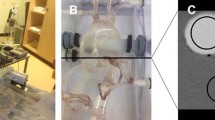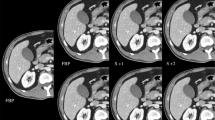Abstract
To evaluate the effect on image quality of a low contrast and radiation dose protocol for cardiac computed tomography (CT) using a low tube voltage, the hybrid-iterative reconstruction algorithm, and a 256-row CT scanner. Before clinical study, we performed phantom experiments to evaluate the hybrid iterative reconstruction technique. We randomly assigned 68 patients undergoing cardiac CT to one of two protocols; 33 were scanned with our conventional 120 kVp protocol, the contrast material (370 mgI/kg body weight) was delivered over 15 s. The other 35 patients underwent scanning at a tube voltage of 80 kVp; the contrast dose, reduced by 50 % (185 mgI/kg), was delivered at the same fractional dose (24.7 mgI/kg/s). The 80 kVp images were post-processed with the 60 % hybrid-iterative reconstruction technique. We evaluated the effective dose (ED), image noise, mean attenuation, and contrast-to-noise ratio (CNR) of each protocol. The hybrid-iterative reconstruction technique offers almost same spatial resolution and noise-power-spectrum curve as compared with filtered back projection reconstruction. There were no decrease in spatial resolution and no shift of spatial frequency in noise power spectrum. The average ED was 74 % lower with the 80- than the 120 kVp protocol (1.4 vs 5.4 mSv). Dunnett’s test showed that there were no significant differences in the image noise, mean attenuation, and CNR between hybrid-iterative-reconstructed 80 kVp scans and 120 kVp scans (28.6 ± 6.5 vs 25.3 ± 4.5, p = 0.18; 475.0 HU ± 87.0 vs 445.3 HU ± 67.7, p = 0.20; 17.1 HU ± 3.5 vs 17.8 HU ± 3.1, p = 0.53). The low kVp scan and hybrid-iterative reconstruction algorithm can dramatically decrease the radiation dose and contrast dose with adequate image quality at cardiac CT of thin adults using a 256-row CT scanner.





Similar content being viewed by others
References
Sodickson A, Baeyens PF, Andriole KP, Prevedello LM, Nawfel RD, Hanson R et al (2009) Recurrent CT, cumulative radiation exposure, and associated radiation-induced cancer risks from CT of adults. Radiology 251:175–184
Berrington de Gonzalez A, Mahesh M, Kim KP, Bhargavan M, Lewis R, Mettler F et al (2009) Projected cancer risks from computed tomographic scans performed in the United States in 2007. Arch Intern Med 169:2071–2077
Brenner DJ, Hall EJ (2007) Computed tomography–an increasing source of radiation exposure. N Engl J Med 357:2277–2284
Raff GL, Gallagher MJ, O’Neill WW, Goldstein JA (2005) Diagnostic accuracy of noninvasive coronary angiography using 64-slice spiral computed tomography. J Am Coll Cardiol 46:552–557
Scheffel H, Alkadhi H, Plass A, Vachenauer R, Desbiolles L, Gaemperli O et al (2006) Accuracy of dual-source CT coronary angiography: first experience in a high pre-test probability population without heart rate control. Eur Radiol 16:2739–2747
Juergens KU, Grude M, Fallenberg EM, Opitz C, Wichter T, Heindel W et al (2002) Using ECG-gated multidetector CT to evaluate global left ventricular myocardial function in patients with coronary artery disease. AJR Am J Roentgenol 179:1545–1550
Hausleiter J, Meyer T, Hadamitzky M, Huber E, Zankl M, Martinoff S et al (2006) Radiation dose estimates from cardiac multislice computed tomography in daily practice: impact of different scanning protocols on effective dose estimates. Circulation 113:1305–1310
Mollet NR, Cademartiri F, van Mieghem CA, Runza G, McFadden EP, Baks T et al (2005) High-resolution spiral computed tomography coronary angiography in patients referred for diagnostic conventional coronary angiography. Circulation 112:2318–2323
Nash K, Hafeez A, Hou S (2002) Hospital-acquired renal insufficiency. Am J Kidney Dis 39:930–936
Katzberg RW, Haller C (2006) Contrast-induced nephrotoxicity: clinical landscape. Kidney Int Suppl S3–S7
McCullough PA, Wolyn R, Rocher LL, Levin RN, O’Neill WW (1997) Acute renal failure after coronary intervention: incidence, risk factors, and relationship to mortality. Am J Med 103:368–375
Scanlon PJ, Faxon DP, Audet AM, Carabello B, Dehmer GJ, Eagle KA et al (1999) ACC/AHA guidelines for coronary angiography. A report of the American College of Cardiology/American Heart Association Task Force on practice guidelines (Committee on Coronary Angiography). Developed in collaboration with the Society for Cardiac Angiography and Interventions. J Am Coll Cardiol 33:1756–1824
Gruberg L, Mintz GS, Mehran R, Gangas G, Lansky AJ, Kent KM et al (2000) The prognostic implications of further renal function deterioration within 48 h of interventional coronary procedures in patients with pre-existent chronic renal insufficiency. J Am Coll Cardiol 36:1542–1548
Weisbord SD, Mor MK, Resnick AL, Hartwig KC, Palevsky PM, Fine MJ (2008) Incidence and outcomes of contrast-induced AKI following computed tomography. Clin J Am Soc Nephrol 3:1274–1281
Utsunomiya D, Yanaga Y, Awai K, Oda S, Funama Y, Namimoto T et al (2011) Baseline incidence and severity of renal insufficiency evaluated by estimated glomerular filtration rates in patients scheduled for contrast-enhanced CT. Acta Radiol 52:581–586
Wintermark M, Maeder P, Verdun FR, Thiran JP, Valley JF, Schnyder P et al (2000) Using 80 kVp versus 120 kVp in perfusion CT measurement of regional cerebral blood flow. Ajnr 21:1881–1884
Sigal-Cinqualbre AB, Hennequin R, Abada HT, Chen X, Paul JF (2004) Low-kilovoltage multi-detector row chest CT in adults: feasibility and effect on image quality and iodine dose. Radiology 231:169–174
Nakayama Y, Awai K, Funama Y, Hatemura M, Imuta M, Nakaura T et al (2005) Abdominal CT with low tube voltage: preliminary observations about radiation dose, contrast enhancement, image quality, and noise. Radiology 237:945–951
Ertl-Wagner BB, Hoffmann RT, Bruning R, Herrmann K, Snyder B, Blume JD et al (2004) Multi-detector row CT angiography of the brain at various kilovoltage settings. Radiology 231:528–535
Waaijer A, Prokop M, Velthuis BK, Bakker CJ, de Kort GA, van Leeuwen MS (2007) Circle of Willis at CT angiography: dose reduction and image quality–reducing tube voltage and increasing tube current settings. Radiology 242:832–839
Ghadri JR, Kuest SM, Goetti R, Fiechter M, Pazhenkottil AP, Nkoulou RN et al (2012) Image quality and radiation dose comparison of prospectively triggered low-dose CCTA: 128-slice dual-source high-pitch spiral versus 64-slice single-source sequential acquisition. Int J Cardiovasc Imaging 28(5):1217–1225
Lell M, Marwan M, Schepis T, Pflederer T, Anders K, Flohr T et al (2009) Prospectively ECG-triggered high-pitch spiral acquisition for coronary CT angiography using dual source CT: technique and initial experience. Eur Radiol 19:2576–2583
Bischoff B, Hein F, Meyer T, Hadamitzky M, Martinoff S, Schomig A et al (2009) Impact of a reduced tube voltage on CT angiography and radiation dose: results of the PROTECTION I study. JACC Cardiovasc Imaging 2:940–946
Hausleiter J, Martinoff S, Hadamitzky M, Martuscelli E, Pschierer I, Feuchtner GM et al (2010) Image quality and radiation exposure with a low tube voltage protocol for coronary CT angiography results of the PROTECTION II Trial. JACC Cardiovasc Imaging 3:1113–1123
Oda S, Utsunomiya D, Funama Y, Awai K, Katahira K, Nakaura T et al (2011) A low tube voltage technique reduces the radiation dose at retrospective ECG-gated cardiac computed tomography for anatomical and functional analyses. Acad Radiol 18:991–999
Renker M, Nance JW Jr, Schoepf UJ, O’Brien TX, Zwerner PL, Meyer M et al (2011) Evaluation of heavily calcified vessels with coronary CT angiography: comparison of iterative and filtered back projection image reconstruction. Radiology 260:390–399
Bittencourt MS, Schmidt B, Seltmann M, Muschiol G, Ropers D, Daniel WG et al (2011) Iterative reconstruction in image space (IRIS) in cardiac computed tomography: initial experience. Int J Cardiovasc Imaging 27:1081–1087
Leipsic J, Labounty TM, Heilbron B, Min JK, Mancini GB, Lin FY et al (2010) Adaptive statistical iterative reconstruction: assessment of image noise and image quality in coronary CT angiography. Ajr 195:649–654
Leipsic J, Labounty TM, Heilbron B, Min JK, Mancini GB, Lin FY et al (2010) Estimated radiation dose reduction using adaptive statistical iterative reconstruction in coronary CT angiography: the ERASIR study. Ajr. 195:655–660
Marin D, Nelson RC, Schindera ST, Richard S, Youngblood RS, Yoshizumi TT et al (2010) Low-tube-voltage, high-tube-current multidetector abdominal CT: improved image quality and decreased radiation dose with adaptive statistical iterative reconstruction algorithm–initial clinical experience. Radiology 254:145–153
Leipsic J, Labounty TM, Heilbron B, Min JK, Mancini GB, Lin FY et al (2010) Adaptive statistical iterative reconstruction: assessment of image noise and image quality in coronary CT angiography. AJR Am J Roentgenol 195:649–654
Funama Y, Taguchi K, Utsunomiya D, Oda S, Yanaga Y, Yamashita Y et al (2011) Combination of a low-tube-voltage technique with hybrid iterative reconstruction (iDose) algorithm at coronary computed tomographic angiography. J Comput Assist Tomogr 35:480–485
Imai E, Horio M, Nitta K, Yamagata K, Iseki K, Tsukamoto Y et al (2007) Modification of the modification of diet in renal disease (MDRD) study equation for Japan. Am J Kidney Dis 50:927–937
Matsuo S, Imai E, Horio M, Yasuda Y, Tomita K, Nitta K et al (2009) Revised equations for estimated GFR from serum creatinine in Japan. Am J Kidney Dis 53:982–992
Hendel RC, Patel MR, Kramer CM, Poon M, Carr JC, Gerstad NA et al (2006) ACCF/ACR/SCCT/SCMR/ASNC/NASCI/SCAI/SIR 2006 appropriateness criteria for cardiac computed tomography and cardiac magnetic resonance imaging: a report of the American College of Cardiology Foundation Quality Strategic Directions Committee Appropriateness Criteria Working Group, American College of Radiology, Society of Cardiovascular Computed Tomography, Society for Cardiovascular Magnetic Resonance, American Society of Nuclear Cardiology, North American Society for Cardiac Imaging, Society for Cardiovascular Angiography and Interventions, and Society of Interventional Radiology. J Am Coll Cardiol 48:1475–1497
Cademartiri F, Nieman K, van der Lugt A, Raaijmakers RH, Mollet N, Pattynama PM et al (2004) Intravenous contrast material administration at 16-detector row helical CT coronary angiography: test bolus versus bolus-tracking technique. Radiology 233:817–823
Singh S, Kalra MK, Hsieh J, Licato PE, Do S, Pien HH et al (2010) Abdominal CT: comparison of adaptive statistical iterative and filtered back projection reconstruction techniques. Radiology 257:373–383
Guimaraes LS, Fletcher JG, Harmsen WS, Yu L, Siddiki H, Melton Z et al (2010) Appropriate patient selection at abdominal dual-energy CT using 80 kV: relationship between patient size, image noise, and image quality. Radiology 257:732–742
Yu L, Li H, Fletcher JG, McCollough CH (2010) Automatic selection of tube potential for radiation dose reduction in CT: a general strategy. Med Phys 37:234–243
Ripsweden J, Brismar TB, Holm J, Melinder A, Mir-Akbari H, Nilsson T et al (2010) Impact on image quality and radiation exposure in coronary CT angiography: 100 kVp versus 120 kVp. Acta Radiol 51:903–909
Park EA, Lee W, Kang JH, Yin YH, Chung JW, Park JH (2009) The image quality and radiation dose of 100-kVp versus 120-kVp ECG-gated 16-slice CT coronary angiography. Korean J Radiol 10:235–243
Leipsic J, Labounty TM, Heilbron B, Min JK, Mancini GB, Lin FY et al (2010) Estimated radiation dose reduction using adaptive statistical iterative reconstruction in coronary CT angiography: the ERASIR study. AJR Am J Roentgenol 195:655–660
Noel PB, Fingerle AA, Renger B, Munzel D, Rummeny EJ, Dobritz M (2011) Initial performance characterization of a clinical noise-suppressing reconstruction algorithm for MDCT. Ajr 197:1404–1409
Oda S, Utsunomiya D, Funama Y, Yonenaga K, Namimoto T, Nakaura T et al (2012) A hybrid iterative reconstruction algorithm that improves the image quality of low-tube-voltage coronary CT angiography. Ajr 198:1126–1131
Hurwitz LM, Yoshizumi TT, Goodman PC, Frush DP, Nguyen G, Toncheva G et al (2007) Effective dose determination using an anthropomorphic phantom and metal oxide semiconductor field effect transistor technology for clinical adult body multidetector array computed tomography protocols. J Comput Assist Tomogr 31:544–549
Conflict of interest
None.
Author information
Authors and Affiliations
Corresponding author
Rights and permissions
About this article
Cite this article
Nakaura, T., Kidoh, M., Sakaino, N. et al. Low contrast- and low radiation dose protocol for cardiac CT of thin adults at 256-row CT: usefulness of low tube voltage scans and the hybrid iterative reconstruction algorithm. Int J Cardiovasc Imaging 29, 913–923 (2013). https://doi.org/10.1007/s10554-012-0153-y
Received:
Accepted:
Published:
Issue Date:
DOI: https://doi.org/10.1007/s10554-012-0153-y




